The relentless pace of modern industry demands tools that are not only intelligent and connected but also robust enough to withstand the harshest operating environments. In this challenging landscape, rugged tablets have emerged as indispensable assets, bridging the gap between sophisticated digital operations and the physical realities of shop floors, expansive warehouses, and dynamic automotive settings. These purpose-built devices are far more than just fortified consumer tablets; they are engineered from the ground up to endure drops, vibrations, extreme temperatures, dust, and water, ensuring uninterrupted productivity where standard devices would quickly fail.
The adoption of rugged tablets represents a pivotal shift for businesses striving for operational excellence, data accuracy, and enhanced worker safety. They empower mobile workforces with real-time access to critical information, streamline complex workflows, and facilitate instant communication, all while operating in conditions that are often characterized by grit, grime, and significant physical hazards. From intricate manufacturing processes to vast logistics networks and precision-driven automotive assembly, the unique capabilities of rugged tablets are proving fundamental to driving efficiency, reducing downtime, and fostering a more agile and responsive industrial ecosystem.
The Unyielding Demands of Industrial Environments
Understanding the intrinsic value of rugged tablets begins with recognizing the unique pressures faced by manufacturing facilities, warehouses, and automotive operations. These environments are inherently challenging, posing significant threats to conventional electronic devices.
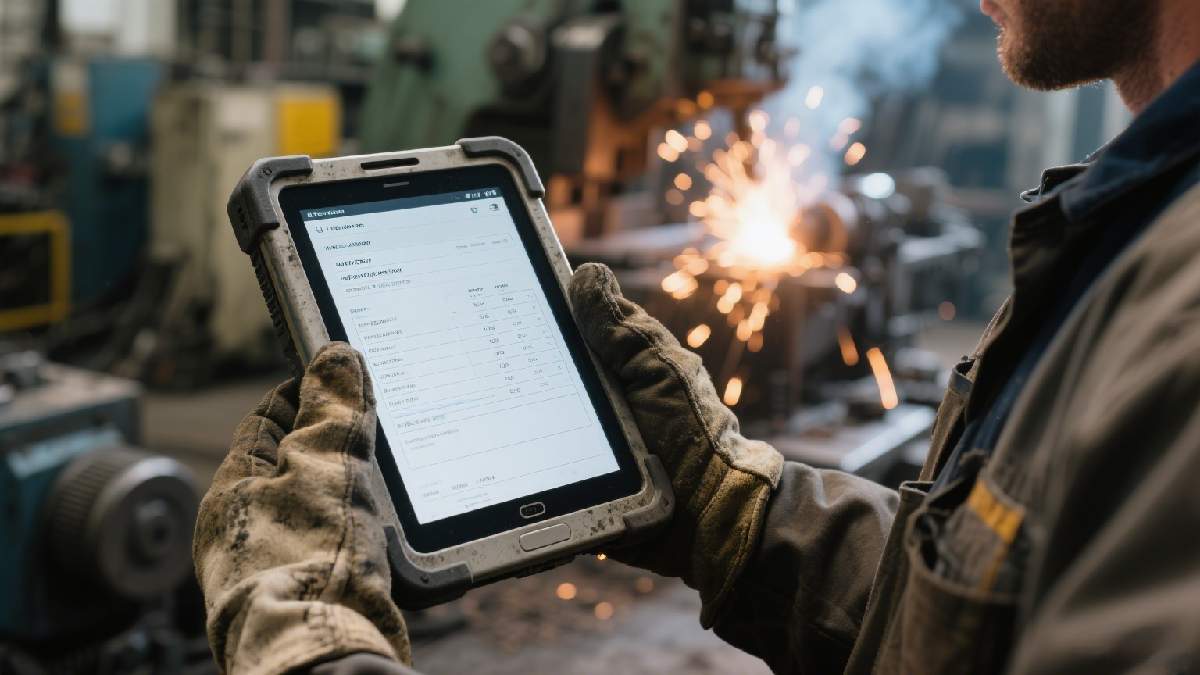
Manufacturing Shop Floors: Precision Amidst Grit
Manufacturing shop floors are dynamic arenas where precision machinery operates alongside human ingenuity. The environment is often characterized by:
- Vibrations and Shocks: Heavy machinery, moving conveyor belts, and material handling equipment generate constant vibrations and occasional impacts. A dropped tablet on a concrete floor is not an “if,” but a “when.”
- Dust and Particulates: Metal shavings, sawdust, chemical powders, and textile fibers are ubiquitous, capable of infiltrating standard device casings and causing irreversible damage to internal components.
- Temperature Extremes: Operations might involve high heat from furnaces or welding, or cold from refrigeration units, pushing consumer-grade electronics beyond their operational limits.
- Chemical Exposure: Oils, coolants, solvents, and other industrial chemicals are commonplace, demanding materials that resist corrosion and degradation.
- Gloves and Poor Lighting: Workers often wear thick gloves for protection, requiring touchscreens that respond accurately, and lighting conditions can vary drastically, necessitating sunlight-readable displays.
In such an environment, the failure of a tablet translates directly into costly downtime, production bottlenecks, and potential safety risks if critical information isn’t immediately accessible. Rugged tablets are designed to shrug off these challenges, maintaining operational integrity in conditions that would render consumer devices useless.
Warehousing: The Epicenter of Logistics and Movement
Warehouses are vast, bustling hubs of activity where goods flow in and out with relentless efficiency. The challenges here are distinct but equally demanding:
- Drops from Height: Forklifts, elevated platforms, and towering shelving units mean devices are frequently dropped from significant heights.
- Extreme Temperatures and Humidity: Warehouses often lack climate control, exposing devices to freezing temperatures in winter or sweltering heat and high humidity in summer. Cold storage facilities present even more extreme conditions.
- Dust and Debris: Cardboard dust, packaging materials, and general debris can clog ports and vents, leading to overheating and malfunction.
- Constant Movement and Impact: Devices are routinely jostled, bumped, and potentially run over by pallet jacks or forklifts in busy aisles.
- Network Connectivity: Large physical spaces can suffer from Wi-Fi dead zones, necessitating robust wireless capabilities.
For warehouse operations, rugged tablets are central to inventory management, order fulfillment, shipping, and receiving. Their reliability is paramount to preventing stock errors, expediting goods movement, and ensuring accurate data capture.
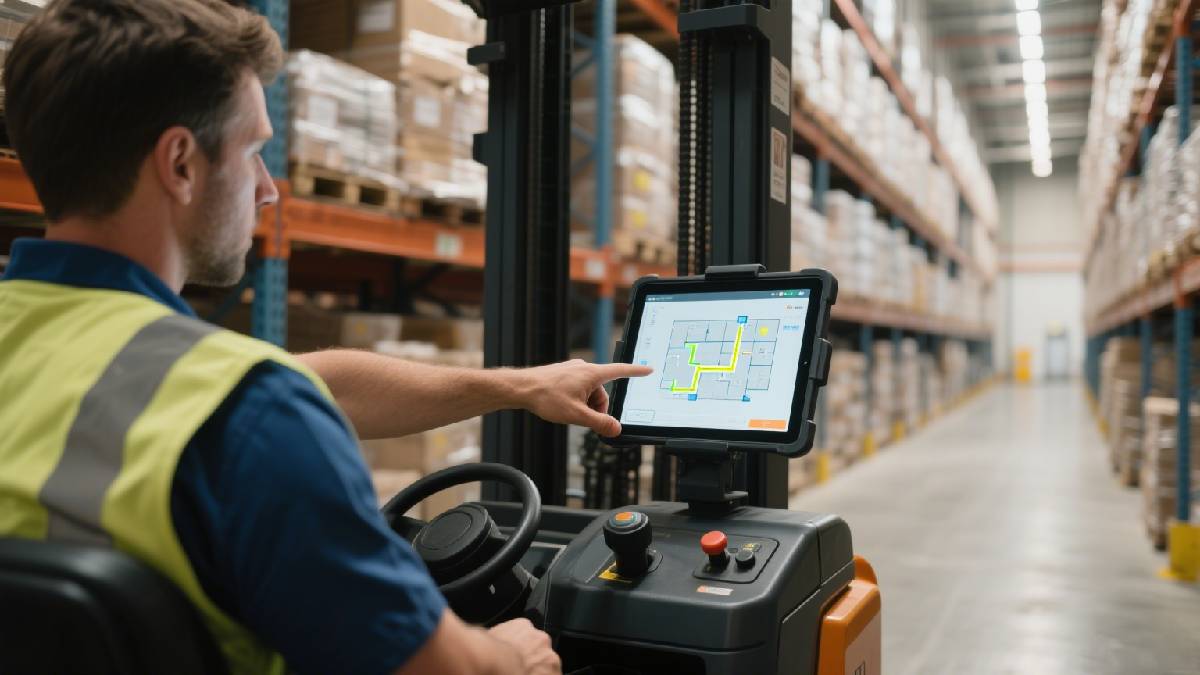
Automotive Industry: Precision, Speed, and Durability
The automotive sector, from manufacturing plants to service centers, embodies a blend of high-tech automation and hands-on mechanical work. Here, rugged tablets play a multifaceted role:
- Assembly Line Vibrations: Devices mounted on trolleys or used by technicians on busy assembly lines must withstand continuous vibration.
- Oil, Grease, and Fluids: Working with engines and vehicle components means constant exposure to automotive fluids, requiring sealed designs that are easy to clean.
- Diagnostic Portability: Technicians need to carry diagnostic tools directly to the vehicle, often in cramped or awkward positions, demanding compact yet durable devices.
- Harsh Garages: Service bays are prone to spills, drops, and impacts, with temperature variations between indoor and outdoor environments.
- Data Security and Speed: Accessing sensitive vehicle data and running complex diagnostic software requires robust processing power and secure connectivity.
Whether for vehicle diagnostics, quality control checks on the assembly line, or mobile parts management, rugged tablets provide the resilience and performance necessary to keep the automotive industry running smoothly and efficiently.
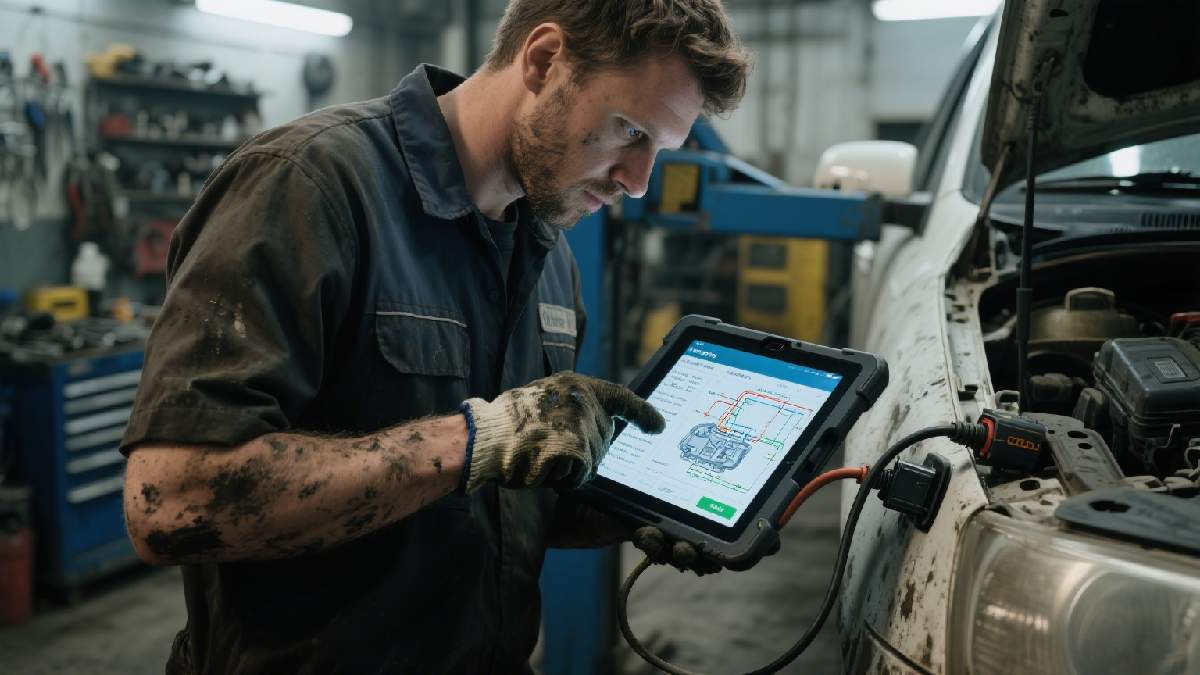
Key Features Defining a True Rugged Tablet
What precisely makes a rugged tablet suitable for these unforgiving environments? It’s a combination of purpose-built design, specialized components, and rigorous testing standards.
Ingress Protection (IP) Ratings: Shield Against the Elements
One of the primary indicators of a tablet’s ruggedness is its IP (Ingress Protection) rating. This two-digit code signifies the level of protection against solids (dust, dirt) and liquids (water). For industrial use, an IP65 rating or higher is generally recommended.
- The first digit (0-6) indicates protection against solid objects, with 6 being dust-tight.
- The second digit (0-9K) indicates protection against liquids, with 5 signifying protection against low-pressure water jets from any direction, and higher numbers indicating greater resistance to powerful jets or even temporary submersion. A rugged tablet with an IP65 rating can effectively resist dust ingress and survive splashes or even direct spray, making it ideal for most shop floor and warehouse applications. Some extreme environments might require IP67 or IP68 for full submersion protection.
MIL-STD-810G/H Certification: Surviving the Gauntlet
Beyond IP ratings, rugged tablets are often certified to MIL-STD-810G/H standards. This is a series of tests developed by the U.S. military to assess equipment durability in environmental extremes. While not a direct certification by the military, manufacturers conduct these tests to demonstrate compliance. Key tests relevant to industrial settings include:
- Shock and Drop: Testing the device’s ability to withstand repeated drops onto hard surfaces from specified heights. For example, MIL-STD-810H specifies resistance to drops from 4-6 feet.
- Vibration: Simulating constant movement and machine vibrations.
- Temperature Extremes: Operating and storing the device in extreme hot and cold conditions.
- Humidity: Testing performance in high humidity environments.
- Altitude: Ensuring functionality at varying atmospheric pressures.
- Salt Fog/Corrosion: Assessing resistance to corrosive agents common in some industrial settings.
A rugged tablet that meets these demanding standards offers a verifiable guarantee of its resilience against physical abuse and environmental stressors.
Display Technology: Clarity and Durability in Any Light
The screen is the primary interface, and in industrial settings, it needs specific attributes:
- Sunlight Readability: High brightness (nits) and anti-glare coatings are crucial for outdoor use in warehouses or brightly lit shop floors, preventing wash-out.
- Glove-Friendly Touchscreens: Capacitive touchscreens that work accurately with thick work gloves are essential, preventing the need for workers to remove protective gear. Some employ specialized digitizers for enhanced precision.
- Impact Resistance: Displays are often made with reinforced glass like Corning Gorilla Glass or even chemically strengthened glass to resist scratches and impacts.
- Multi-Touch Capabilities: Essential for intuitive navigation and precise data entry.
Connectivity: Always On, Always Connected
Reliable connectivity is the backbone of any digital workflow. Rugged tablets offer robust options:
- Wi-Fi 6/6E: For high-speed, reliable wireless network access across large facilities.
- 4G LTE/5G: Crucial for mobile workforces operating across vast areas or for field service applications where Wi-Fi isn’t available. This ensures real-time data synchronization.
- Bluetooth: For connecting to peripherals like barcode scanners, RFID readers, portable printers, or diagnostic tools.
- GPS: For location tracking, asset management, and navigation, particularly in large outdoor yards or for fleet management in automotive.
- NFC (Near Field Communication): For quick, secure data exchange or access control.
Battery Life and Swappability: Sustained Operation
Industrial shifts are long, and device downtime for charging is disruptive.
- Extended Battery Life: Many rugged tablets offer 10-12+ hours of battery life on a single charge, supporting full shifts.
- Hot-Swappable Batteries: This feature allows users to replace a depleted battery with a fully charged one without shutting down the device, ensuring continuous operation. This significantly boosts productivity by eliminating charging downtime.
Processing Power and Memory: Running Complex Applications
Modern industrial applications are increasingly data-intensive and demand capable hardware.
- Robust Processors: Industrial tablets feature Intel Core i-series, Intel Atom, or ARM-based processors, providing the necessary horsepower for enterprise resource planning (ERP) systems, manufacturing execution systems (MES), diagnostic software, and CAD viewing.
- Ample RAM and Storage: Sufficient RAM (8GB-16GB+) and fast solid-state drives (SSDs) are critical for smooth multitasking and quick application loading.
Integrated Data Capture Tools: Beyond the Keyboard
Rugged tablets often integrate specialized tools to streamline data collection:
- Integrated Barcode Scanners (1D/2D): Essential for inventory management, asset tracking, and quality control, enabling rapid and accurate data input. These are typically industrial-grade scanners, offering faster and more reliable reads than camera-based scanning.
- RFID Readers: For tracking high volumes of assets or inventory, particularly in warehousing and logistics.
- High-Resolution Cameras: For documenting defects, capturing visual evidence, or conducting remote inspections.
- Optional Fingerprint Readers: For enhanced security and quick user authentication.
Ergonomics and Mounting Options: User Comfort and Versatility
While durability is key, usability cannot be overlooked.
- Lightweight Design (Relative to Ruggedness): Though more substantial than consumer tablets, engineers strive for a balance of ruggedness and portability.
- Hand Straps and Shoulder Straps: For comfortable and secure carrying throughout a shift.
- Vehicle Docks and Forklift Mounts: Allowing for secure mounting and power delivery in moving vehicles, turning the tablet into a fixed workstation when needed.
- Desktop Docks: For seamless transition to an office environment for data offloading or reporting.
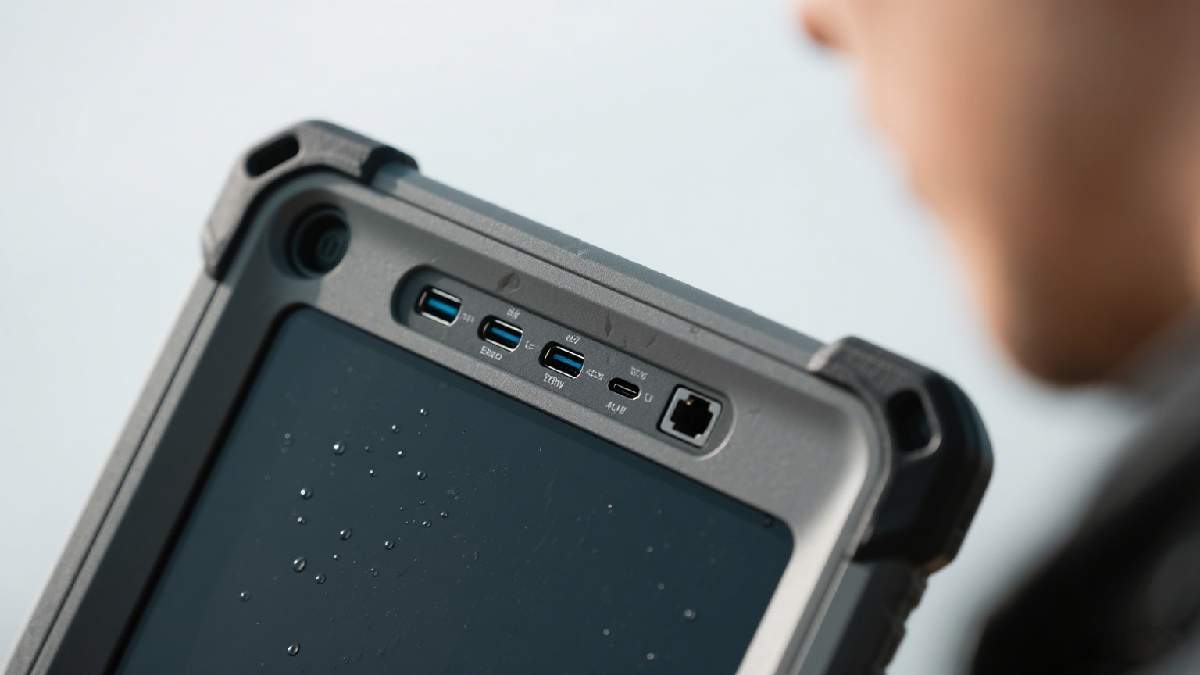
Applications Across Industries: Where Rugged Tablets Shine
The versatility and resilience of rugged tablets make them invaluable across a spectrum of industrial applications.
Manufacturing Shop Floor: Driving Efficiency and Quality
On the manufacturing floor, rugged tablets are transforming operations by providing real-time data and enhancing worker mobility.
- Work Order Management: Technicians can access digital work orders, assembly instructions, and schematics directly on the shop floor, reducing paper waste and ensuring workers have the most current information.
- Quality Control and Inspection: Operators can conduct digital quality checks, record defects with integrated cameras, and log compliance data instantly, improving traceability and reducing errors.
- Preventive Maintenance: Access to machine diagnostics, maintenance schedules, and repair manuals on a rugged tablet allows technicians to perform proactive maintenance, minimizing unplanned downtime.
- Asset Tracking: Scanning barcodes or RFID tags on tools and equipment helps manage inventory, prevent loss, and track usage.
- Inventory Management at the Line: Real-time updates on component availability directly at the assembly line prevent production delays due to material shortages.
- Machine Monitoring and SCADA Access: Some rugged tablets can interface with SCADA (Supervisory Control and Data Acquisition) systems, allowing operators to monitor machine performance and adjust parameters remotely.
Warehousing & Logistics: Optimizing Flow and Accuracy
In the expansive and fast-paced world of warehousing, rugged tablets are central to efficient supply chain management.
- Inventory Receiving and Putaway: Scanning incoming goods, validating orders, and directing precise putaway locations instantly updates inventory records, reducing manual errors.
- Order Picking and Packing: Digital pick lists guide workers along optimal routes, and integrated scanners confirm item selection, accelerating fulfillment and reducing mis-picks.
- Shipping and Loading: Verifying outgoing shipments, generating labels, and managing carrier manifests directly from the loading dock ensure accurate and timely dispatch.
- Cycle Counting and Stock Audits: Expediting inventory counts with integrated scanners, improving accuracy and reducing disruption to operations.
- Cross-Docking Operations: Managing the direct transfer of goods from incoming to outgoing trucks with real-time updates.
- Forklift and Vehicle Integration: Mounted rugged tablets provide drivers with navigation, task assignments, and safety checklists, optimizing material handling routes and operational safety.
Automotive Industry: From Assembly to Service
The automotive sector leverages rugged tablets for a wide array of tasks, from the production line to the service bay.
- Vehicle Diagnostics and Repair: Technicians use rugged tablets to connect to onboard diagnostic (OBD) ports, run diagnostic software, access repair manuals, and view wiring diagrams, significantly speeding up fault identification and repair processes.
- Quality Assurance on the Assembly Line: Inspectors use tablets to perform final quality checks, document any imperfections with photos, and verify component installation.
- Parts Inventory and Ordering: Managing parts inventory in service centers, ordering replacements, and tracking delivery status directly from the shop floor.
- Vehicle Tracking and Logistics: In large manufacturing plants or shipping yards, rugged tablets assist in tracking vehicles through various stages of production and dispatch.
- Customer Service and Digital Check-ins: Service advisors can use tablets for vehicle check-ins, capturing customer signatures, and presenting service recommendations digitally, enhancing the customer experience.
- Pre-Delivery Inspections (PDI): Conducting detailed PDI checklists for new vehicles before customer handover, ensuring all features are functional and documented.
Selecting the Right Rugged Tablet: Key Considerations
Choosing the optimal rugged tablet is not a one-size-fits-all decision. Businesses must carefully evaluate their specific operational needs, environmental conditions, and budget constraints.
Operating System: Familiarity and Ecosystem Integration
- Windows: Offers compatibility with existing enterprise software, easy network integration, and powerful processing for complex applications. Many industrial software solutions are Windows-based.
- Android: Provides a highly customizable, user-friendly interface, excellent app ecosystem, and often lower cost of ownership. Ideal for task-specific applications and barcode scanning workflows.
- Linux: Less common in general use but offers high customizability and security for specific industrial applications.
The choice often depends on existing IT infrastructure, software compatibility, and workforce familiarity.
Form Factor and Size: Portability vs. Screen Real Estate
Rugged tablets come in various sizes, typically ranging from 7 inches to 12 inches or larger.
- Smaller Tablets (7-8 inches): More portable, lighter, and easier to carry for mobile workers who need constant access to data while on the move (e.g., inventory clerks, field technicians).
- Larger Tablets (10-12+ inches): Offer more screen real estate for viewing complex schematics, detailed forms, or multiple applications simultaneously. Ideal for mounted applications (forklifts, vehicle dashboards) or as a primary workstation on a cart.
Consider the user’s primary tasks and how the device will be carried or mounted throughout a shift.
Connectivity Requirements: Ensuring Constant Data Flow
Beyond Wi-Fi and cellular, consider the need for:
- Dedicated GPS modules: For highly accurate location tracking.
- Specific RFID frequencies: HF, LF, or UHF depending on the tags being read.
- Specific port types: USB-A, USB-C, Ethernet, serial ports for connecting legacy equipment or specialized diagnostic tools.
Future-proofing for emerging technologies like 5G should also be a consideration for long-term investments.
Accessories and Peripherals: Extending Functionality
A rugged tablet‘s utility is often enhanced by a robust ecosystem of accessories:
- Vehicle Docks and Mounts: For secure in-vehicle or forklift use, often providing power and external antenna connections.
- Desktop Cradles/Docks: For charging and connecting to monitors, keyboards, and mice when used as a desktop replacement.
- External Barcode Scanners/RFID Readers: If integrated scanners aren’t sufficient or if specialized scanning is required.
- Stands and Hand Straps: For comfortable, prolonged use.
- Spare Batteries and Multi-Bay Chargers: Essential for continuous operation in multi-shift environments.
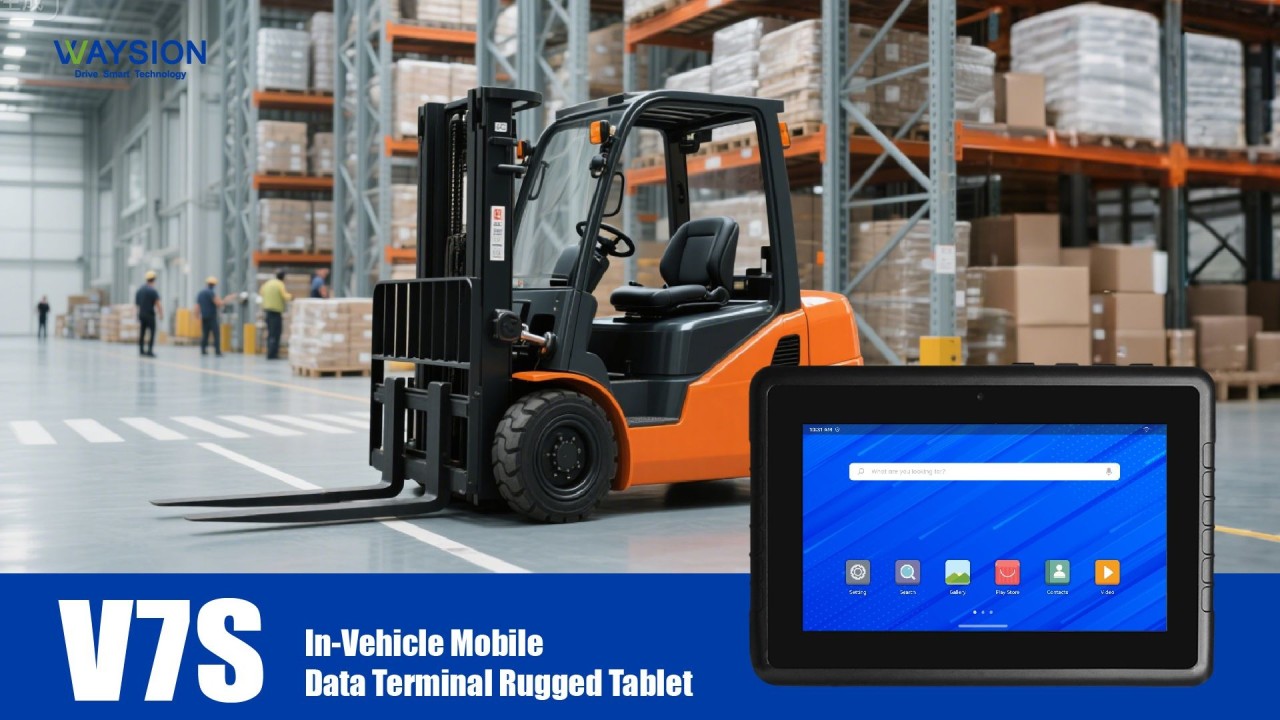
Total Cost of Ownership (TCO): Beyond the Initial Price Tag
While rugged tablets have a higher upfront cost than consumer devices, their TCO is often significantly lower over their lifespan.
- Durability and Longevity: They last much longer, reducing replacement costs.
- Reduced Downtime: Fewer failures mean less disruption to operations and higher productivity.
- Lower Repair Costs: Many rugged devices are designed for easier repairability, or come with comprehensive warranties and support plans.
- Increased Worker Efficiency: Empowered workers lead to fewer errors and faster task completion.
Factoring in these long-term benefits is crucial when justifying the investment.
Software Integration and Development: Seamless Workflows
Consider how the rugged tablet will integrate with existing enterprise software (ERP, MES, WMS) or if new custom applications need to be developed. Many manufacturers offer Software Development Kits (SDKs) to facilitate integration of their specific hardware features (e.g., barcode scanners) with custom applications. Ensuring a smooth data flow between the tablet and backend systems is paramount.
The ROI of Ruggedization: A Strategic Investment
Investing in rugged tablets is not merely a purchasing decision; it’s a strategic move that yields significant returns across several key areas for manufacturing, warehousing, and automotive operations.
Reduced Downtime and Enhanced Productivity
The most immediate and tangible benefit of rugged tablets is their ability to withstand harsh environments. This translates directly into:
- Fewer Device Failures: Less time spent replacing or repairing broken devices.
- Uninterrupted Workflow: Workers can continue tasks without interruptions due to device malfunction.
- Faster Data Capture: Integrated scanners and intuitive interfaces speed up data entry, reducing manual errors and saving time.
- Real-time Decision Making: Immediate access to data empowers workers to make informed decisions on the spot, preventing bottlenecks.
Improved Data Accuracy and Traceability
Manual data entry is prone to errors. Rugged tablets equipped with integrated scanners and digital forms significantly improve data integrity.
- Elimination of Transcription Errors: Scanning barcodes and RFID tags directly captures accurate data.
- Instant Updates: Data entered on the tablet is immediately synchronized with backend systems, providing an up-to-the-minute view of operations.
- Enhanced Audit Trails: Digital records provide a clear, timestamped history of actions, crucial for quality control and compliance.
Enhanced Worker Safety and Morale
By providing reliable tools and reducing physical strain, rugged tablets contribute to a safer and more engaged workforce.
- Reduced Risk of Injury: Eliminating the need for paper documentation in hazardous areas or for carrying fragile consumer devices.
- Ergonomic Design: Features like hand straps and lightweight designs reduce user fatigue.
- Improved Communication: Facilitating instant communication between workers and supervisors, especially in emergencies.
- Empowered Workforce: Giving workers reliable, high-performance tools demonstrates an investment in their capabilities, boosting morale and efficiency.
Cost Savings Through Longevity and Efficiency
While the initial investment is higher, the long-term cost savings are substantial.
- Extended Device Lifespan: Rugged tablets can last 3-5 times longer than consumer devices in industrial settings.
- Lower IT Support Costs: Fewer break-fix issues reduce the burden on IT staff and minimize repair expenditures.
- Reduced Consumables: Eliminating paper-based forms saves on printing, storage, and disposal costs.
- Optimized Operations: The efficiency gains in inventory, production, and maintenance directly impact the bottom line.
The Future of Industrial Computing: Beyond Today’s Rugged Tablet
The evolution of rugged tablets is closely tied to the broader trends in industrial automation, IoT, and AI. Future developments promise even more sophisticated capabilities.
- Enhanced Connectivity: Widespread adoption of 5G will enable ultra-low latency and higher bandwidth, critical for real-time data streaming, remote control of machinery, and augmented reality applications.
- Augmented Reality (AR) Integration: Future rugged tablets will increasingly incorporate advanced AR capabilities, allowing workers to overlay digital instructions onto physical equipment, visualize complex repairs, or identify components more easily. This will revolutionize training, maintenance, and quality control.
- AI and Machine Learning at the Edge: Devices will be equipped with more powerful processors capable of running AI algorithms directly on the device (“edge computing”), enabling predictive maintenance, real-time anomaly detection, and advanced visual inspection without relying solely on cloud connectivity.
- Modular and Customizable Designs: More modular designs will allow businesses to easily swap out components (e.g., different scanners, thermal cameras, specialized sensors) to adapt the tablet to evolving operational needs without replacing the entire device.
- Improved Power Management: Advancements in battery technology and power efficiency will further extend operational times, potentially enabling multi-day use without charging.
- Cybersecurity Enhancements: As tablets become more integrated into critical industrial systems, robust cybersecurity features will be paramount, including advanced encryption, secure boot processes, and multi-factor authentication.
- Sustainability: Manufacturers will increasingly focus on designing rugged tablets with recyclable materials and energy-efficient components, aligning with broader corporate sustainability goals.
These advancements underscore the growing importance of rugged tablets not just as tools for data capture, but as intelligent, interconnected hubs for the digital industrial enterprise.
Frequently Asked Questions (FAQs)
Q1: What exactly defines a “rugged tablet” compared to a consumer tablet with a protective case?
A1: A rugged tablet is engineered from the ground up for harsh environments, meeting specific military (MIL-STD-810) and ingress protection (IP) standards. It features internal shock absorption, sealed ports, specialized display glass, and robust internal components designed to withstand drops, vibrations, extreme temperatures, dust, and water. A consumer tablet with a case provides minimal protection against these severe industrial conditions and lacks the specialized internal engineering for true durability and performance under duress.
Q2: Are rugged tablets significantly more expensive than regular tablets? What’s the justification for the higher cost?
A2: Yes, rugged tablets typically have a higher upfront cost. This is justified by their superior durability, specialized components, rigorous testing, and longer lifespan in demanding environments. While a consumer tablet might cost a few hundred dollars and last a year or two in an industrial setting (if it even survives), a rugged tablet costing a few thousand dollars can last five years or more. The total cost of ownership (TCO) is often much lower for rugged tablets when factoring in reduced replacement costs, less downtime due to device failure, and increased worker productivity.
Q3: Can rugged tablets run the same software as standard computers or tablets?
A3: Yes, many rugged tablets run full versions of operating systems like Windows (e.g., Windows 10/11 Pro), allowing them to run virtually any enterprise software, including ERP, MES, and CAD applications. Others run Android, suitable for highly mobile, task-specific applications. The choice of operating system depends on your existing IT infrastructure and software requirements.
Q4: How do rugged tablets perform in extreme temperatures, like a freezer warehouse or a hot factory floor?
A4: Rugged tablets are specifically designed to operate in wide temperature ranges. They typically have an operating temperature range from well below freezing (e.g., -20°C / -4°F) up to high temperatures (e.g., 50°C / 122°F or higher). This is due to specialized components, thermal management systems, and battery technology that can perform reliably in such conditions, unlike consumer devices that would quickly fail or shut down.
Q5: What’s the battery life like on a rugged tablet, and can I swap batteries?
A5: Battery life varies by model and usage, but most rugged tablets are designed to last a full shift, typically 8-12 hours or more, on a single charge. Many models also offer hot-swappable battery options, allowing users to replace a depleted battery with a fresh one without powering down the device, ensuring continuous operation throughout multi-shift workflows.
Q6: Are integrated barcode scanners on rugged tablets better than using a smartphone camera for scanning?
A6: Absolutely. Integrated barcode scanners in rugged tablets are purpose-built for high-volume, rapid, and accurate scanning. They offer faster read rates, can scan damaged or poorly printed barcodes, and perform reliably in varying lighting conditions (including low light). Smartphone cameras are not designed for industrial scanning workflows and are significantly slower, less accurate, and more prone to errors, especially over sustained periods.
Q7: How important is MIL-STD-810G/H certification for a rugged tablet?
A7: MIL-STD-810G/H certification is highly important as it indicates that the rugged tablet has been tested against a comprehensive set of environmental and physical stressors, including shock, vibration, drops, temperature extremes, and humidity. While it’s a self-certification by manufacturers, it provides a strong assurance that the device meets a recognized standard for durability and reliability in challenging conditions. Look for tablets that specifically state which MIL-STD-810 tests they have passed.
Conclusion
The industrial landscape of manufacturing shop floors, expansive warehouses, and the precision-driven automotive sector is undergoing a profound digital transformation. At the heart of this evolution lies the rugged tablet, a device meticulously engineered to thrive where conventional electronics falter. These robust computing platforms are far more than just fortified screens; they are critical enablers of real-time data capture, streamlined workflows, and enhanced operational efficiency.
By providing workers with reliable access to vital information, facilitating seamless communication, and standing up to the rigors of dust, drops, and extreme temperatures, rugged tablets are proving their worth as indispensable tools. The investment in these purpose-built devices translates directly into tangible benefits: reduced downtime, improved data accuracy, enhanced worker safety, and a demonstrably lower total cost of ownership over their extended lifespan. As industries continue to embrace automation and the Internet of Things, the role of the rugged tablet will only grow, solidifying its position as a cornerstone of the connected, intelligent industrial future. Businesses looking to truly optimize their operations and empower their mobile workforce in the most challenging environments will find that the resilience and performance of rugged tablets are not just advantageous, but absolutely essential.
https://www.waysion.com/blog/rugged-tablets-manufacturing-warehousing-automotive-industrial/
评论
发表评论